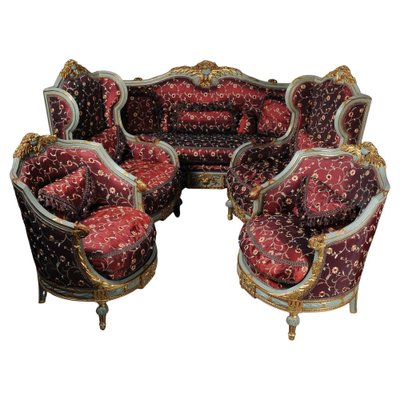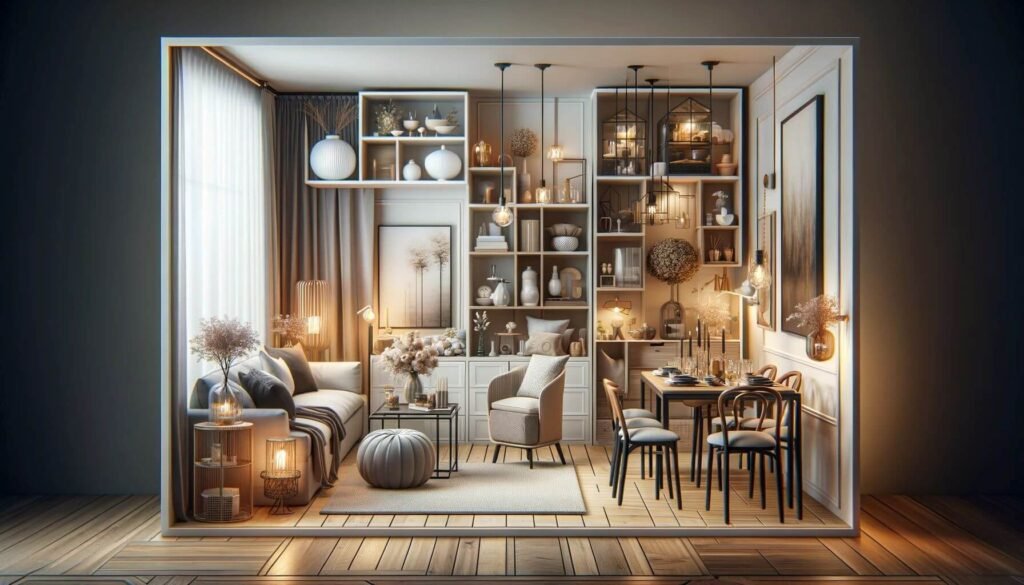As an Amazon Associate I earn from qualifying purchases.
Creating a secondary furniture grouping adds depth and function to a room. It complements the main furniture set and enhances the overall design.
In any space, secondary furniture groupings can serve various purposes. They offer additional seating, storage, or display options, making the room more versatile and inviting. These groupings can include pieces like side tables, accent chairs, or even a cozy reading nook.
The goal is to create a harmonious and functional environment that supports the primary furniture arrangement. Whether you’re looking to fill an empty corner or add a touch of style, understanding what to place in a secondary furniture grouping can help you make the most of your space. Let’s explore how to enhance your home with smart furniture choices.
Introduction To Secondary Furniture Grouping
Many homes have a primary furniture arrangement. This usually includes a sofa, coffee table, and a few chairs. But what about the other spaces in your home? Secondary furniture grouping involves arranging additional pieces to create more functional and visually appealing areas. It can turn unused corners into cozy nooks or practical zones.
Purpose And Benefits
The purpose of secondary furniture grouping is to make the most of every inch of your space. It can serve many functions:
- Reading corners with a comfortable chair and lamp.
- Home office setups with a desk and chair.
- Play areas for kids with a small table and chairs.
- Conversation zones with a pair of chairs and a small table.
These groupings can add value by:
- Improving the functionality of your space.
- Enhancing the visual appeal of your home.
- Creating specific zones for different activities.
- Making your home feel more organized and welcoming.
Design Principles
When creating secondary furniture groupings, follow these design principles:
| Principle | Explanation |
|---|---|
| Balance | Distribute furniture evenly to avoid cluttered or empty areas. |
| Scale | Choose pieces that fit the size of the space. Avoid oversized furniture. |
| Harmony | Ensure that the furniture pieces complement each other. Stick to a color scheme. |
| Functionality | Each piece should serve a purpose. Avoid purely decorative items. |
By following these principles, you can create secondary furniture groupings that enhance both the functionality and aesthetics of your home.
Choosing The Right Furniture
Choosing the right furniture for your secondary furniture grouping can be a fun task. It is important to select pieces that complement your main furniture. This will create a cohesive and inviting space. Let’s explore some essential and complementary items that could enhance your room.
Essential Pieces
Start with the basics. A sofa or loveseat is a must-have. These pieces provide comfortable seating for guests. Consider a coffee table. This serves as a functional centerpiece. It is perfect for holding drinks, books, and decor items.
Don’t forget about side tables. These are great for placing lamps or personal items. A television stand or media console is also essential. This keeps your entertainment area organized and tidy.
Complementary Items
Once you have the essentials, think about adding complementary items. Accent chairs are a great choice. They add extra seating and style. A stylish rug can tie the room together. It adds warmth and comfort underfoot.
Consider adding a bookshelf. This not only holds books but also displays decor pieces. Art and wall decor can enhance the aesthetic appeal of your room. Throw pillows and blankets add comfort and a touch of color.
Lighting is crucial too. Floor lamps and table lamps provide necessary light and enhance the room’s ambiance. Plants and greenery can also bring life and freshness to your space.
Creating A Cozy Reading Nook
A secondary furniture grouping can create a special corner in your home. One popular option is a cozy reading nook. This space invites relaxation and offers a quiet place to enjoy a good book.
Comfortable Seating
The heart of any reading nook is comfortable seating. Choose a chair with soft cushions. A plush armchair or a chaise lounge works well. Ensure the seat supports your back. You should feel relaxed and at ease.
Add a throw blanket for extra warmth. Consider a few decorative pillows. These add comfort and style. The goal is to create a spot where you can sit for hours.
Adequate Lighting
Good lighting is essential in a reading nook. Natural light is best during the day. Place your seat near a window. This allows you to read without straining your eyes.
For evening reading, a good lamp is key. Choose a floor or table lamp with a bright bulb. Adjustable lamps are ideal. You can direct the light exactly where you need it.
Soft lighting creates a cozy atmosphere. Consider adding fairy lights or a small candle. This adds charm and makes the space inviting.

Credit: www.pamono.eu
Designing An Inviting Conversation Area
Creating an inviting conversation area can transform a room. It encourages interaction and fosters a welcoming atmosphere. This area should be comfortable and well-planned. Thoughtful design choices make a big difference. Let’s explore key elements for success.
Seating Arrangement
The seating arrangement is crucial. It sets the tone for the space. Choose furniture pieces that offer comfort and style. Consider these options:
- Sofas: A plush sofa can serve as the focal point.
- Armchairs: Pair armchairs with the sofa for balance.
- Ottomans: Ottomans provide extra seating and a place to rest feet.
- Sectionals: For larger spaces, sectionals offer flexibility.
Arrange the seating to face each other. This fosters conversation. Avoid placing seats in a straight line. Instead, create a circular or square layout. This makes the space feel more intimate.
Incorporating Tables
Tables are essential in a conversation area. They provide surfaces for drinks, books, and decor. Choose tables that complement the seating. Here are some options:
| Table Type | Features | Benefits |
|---|---|---|
| Coffee Tables | Low height, central placement | Perfect for drinks and small items |
| Side Tables | Compact, versatile | Great for lamps and books |
| Nesting Tables | Stackable, space-saving | Ideal for small rooms |
Place a coffee table in the center. Add side tables near chairs and sofas. Ensure tables are within reach. This enhances convenience and comfort.
In summary, a well-designed conversation area invites people to relax and chat. Focus on comfortable seating and functional tables. These choices create a space where everyone feels at home.
Setting Up A Functional Workspace
Creating a functional workspace is essential for productivity and comfort. The right furniture can make a significant difference. A secondary furniture grouping includes items like ergonomic chairs and efficient desks. These items help in setting up a productive workspace.
Ergonomic Chairs
Ergonomic chairs support good posture and reduce strain. This type of chair is adjustable. It has features like lumbar support, adjustable armrests, and seat height. These features help in maintaining a comfortable and healthy seating position.
- Lumbar Support: Keeps the lower back properly aligned.
- Adjustable Armrests: Prevents shoulder and neck strain.
- Seat Height: Ensures feet rest flat on the floor.
Investing in an ergonomic chair can prevent many health issues. It enhances comfort and productivity in your workspace.
Efficient Desks
An efficient desk is a key component of a functional workspace. The desk should have enough space to accommodate all necessary items. It should also promote a clutter-free environment.
| Feature | Benefit |
|---|---|
| Adjustable Height | Allows switching between sitting and standing positions. |
| Ample Surface Area | Provides space for computer, documents, and other essentials. |
| Cable Management | Keeps wires organized and out of the way. |
Efficient desks come in various designs and materials. Choose one that fits your needs and complements your workspace.

Credit: www.instagram.com
Adding Storage Solutions
Adding storage solutions to your secondary furniture grouping can enhance both style and functionality. Effective storage helps maintain a clutter-free space. It also adds a touch of elegance to your home. Let’s explore some stylish and practical storage options.
Stylish Shelving
Stylish shelving can transform a room. Open shelves offer a place to display decorative items. They can house books, plants, or family photos. Choose shelves that match your room’s decor. Floating shelves provide a modern look. Wooden shelves bring warmth and a rustic feel. Glass shelves add a touch of sophistication. Arrange items by color or size for a cohesive look.
Hidden Storage Options
Hidden storage options keep your space tidy and organized. Consider furniture with built-in storage. Ottomans with hidden compartments can store blankets and pillows. Coffee tables with drawers offer a place for remote controls and magazines. Beds with storage underneath can hold extra linens. Use storage benches in entryways for shoes and bags. Keep clutter out of sight while maintaining easy access to essentials.
Enhancing With Decorative Accents
Enhancing with decorative accents brings life and character to your secondary furniture grouping. These accents can transform a bland space into a vibrant and welcoming area. By adding a few key pieces, you can elevate the overall aesthetic and comfort of your room. Explore different decorative accents to find what suits your style and space.
Artwork And Wall Decor
Artwork and wall decor add personality to your secondary furniture grouping. Choose pieces that reflect your taste and complement your furniture. This could be paintings, photographs, or even wall sculptures. Arrange them thoughtfully to create a balanced and visually appealing look.
Consider the size and color of your artwork. Ensure it matches the overall theme of the room. A large piece can be a focal point, while smaller pieces can be grouped together. This creates a cohesive and stylish display.
Textiles And Rugs
Textiles and rugs can add warmth and texture to your secondary furniture grouping. Use cushions, throws, and blankets to introduce color and comfort. These items are easy to change, allowing you to update your decor without much effort.
Rugs define the space and anchor your furniture. Choose a rug that fits well with the size of your furniture grouping. It should complement the color scheme and style of the room. A well-chosen rug can tie everything together, making the space feel complete and inviting.
Incorporating Multifunctional Pieces
When organizing a home, incorporating multifunctional pieces into a secondary furniture grouping can be a practical and stylish choice. These pieces save space, add functionality, and often serve more than one purpose. Let’s explore some popular options.
Convertible Furniture
Convertible furniture is highly adaptable. It changes form to meet different needs. A common example is the sofa bed. By day, it serves as a comfortable sofa. By night, it turns into a bed. This dual function is perfect for small spaces or guest rooms.
Another great piece is the folding dining table. It can be compact when not in use. When guests arrive, it expands to accommodate more people. Such versatility makes convertible furniture a smart investment.
Dual-purpose Items
Dual-purpose items are designed to perform two functions. An example is a storage ottoman. It serves as a seat or footrest. It also provides hidden storage space for blankets, books, or toys.
Consider a desk with built-in shelves. It offers a workspace and storage in one piece. This is ideal for home offices or study areas. The shelves keep your items organized and within reach.
Here is a table showcasing some multifunctional furniture ideas:
| Furniture Piece | Primary Function | Secondary Function |
|---|---|---|
| Sofa Bed | Sofa | Bed |
| Storage Ottoman | Seating | Storage |
| Folding Dining Table | Dining Table | Compact Storage |
| Desk with Shelves | Workspace | Storage |
- Convertible furniture adapts to different needs.
- Dual-purpose items save space and add functionality.
Conclusion: Bringing It All Together
Creating a secondary furniture grouping in your living space can add both functionality and style. This additional area can serve various purposes, from a cozy reading nook to a practical workspace. By carefully selecting and arranging pieces, you can enhance the overall atmosphere of your room. Let’s explore how to personalize your space and add those final touches.
Personalizing Your Space
Start by considering your needs and preferences. Do you want a quiet place to read? Or perhaps a comfortable spot for morning coffee? Choose furniture that fits the purpose of the space.
- Seating: Opt for a comfortable armchair or a stylish loveseat.
- Tables: A small coffee table or side table can be handy.
- Lighting: A floor lamp or table lamp can set the mood.
Think about colors and textures that complement your existing decor. Use throws, cushions, and rugs to add warmth and personality. Incorporate items that reflect your style, like artwork or decorative pieces.
Final Touches
After arranging the main furniture pieces, it’s time to add the final touches. These details can make your secondary grouping feel complete.
- Plants: Add greenery for a fresh, lively touch.
- Books: Stack a few favorite books on the table.
- Personal items: Display photos, souvenirs, or collectibles.
Consider functionality. For a reading nook, include a bookshelf or magazine rack. If it’s a workspace, ensure there’s adequate storage for supplies. These elements will make the area both beautiful and practical.

Credit: ilcouncil.org
Frequently Asked Questions
What Is A Secondary Furniture Grouping?
A secondary furniture grouping is an additional seating or functional area in a room. It complements the primary arrangement and adds versatility to the space.
What Items Are Common In Secondary Furniture Groupings?
Common items include accent chairs, side tables, and ottomans. These pieces enhance functionality and comfort without overwhelming the primary furniture setup.
How Can Secondary Furniture Groupings Enhance A Room?
Secondary furniture groupings create more seating options and conversation areas. They add depth, style, and functionality to any room layout.
Where Should A Secondary Furniture Grouping Be Placed?
A secondary furniture grouping can be placed near windows, in corners, or opposite the main seating area. This placement maximizes space usage.
Conclusion
Secondary furniture grouping adds function and charm to any room. It helps define spaces and enhances comfort. Think about seating arrangements, small tables, and storage units. Each piece should have a purpose. Be thoughtful with your choices. It can make your space feel cozy and organized.
Experiment with different layouts. See what works best for your lifestyle. Enjoy the process. Happy decorating!
As an Amazon Associate, I earn from qualifying purchases.


